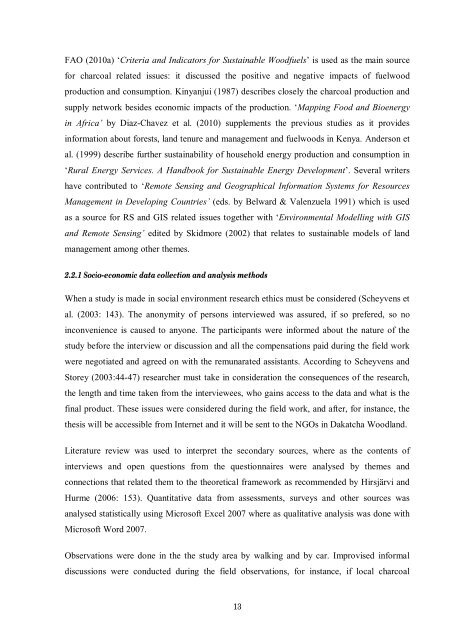The Significance and Sustainability of Charcoal Production in the ...
The Significance and Sustainability of Charcoal Production in the ...
The Significance and Sustainability of Charcoal Production in the ...
Create successful ePaper yourself
Turn your PDF publications into a flip-book with our unique Google optimized e-Paper software.
FAO (2010a) ‘Criteria <strong>and</strong> Indicators for Susta<strong>in</strong>able Woodfuels’ is used as <strong>the</strong> ma<strong>in</strong> source<br />
for charcoal related issues: it discussed <strong>the</strong> positive <strong>and</strong> negative impacts <strong>of</strong> fuelwood<br />
production <strong>and</strong> consumption. K<strong>in</strong>yanjui (1987) describes closely <strong>the</strong> charcoal production <strong>and</strong><br />
supply network besides economic impacts <strong>of</strong> <strong>the</strong> production. ‘Mapp<strong>in</strong>g Food <strong>and</strong> Bioenergy<br />
<strong>in</strong> Africa’ by Diaz-Chavez et al. (2010) supplements <strong>the</strong> previous studies as it provides<br />
<strong>in</strong>formation about forests, l<strong>and</strong> tenure <strong>and</strong> management <strong>and</strong> fuelwoods <strong>in</strong> Kenya. Anderson et<br />
al. (1999) describe fur<strong>the</strong>r susta<strong>in</strong>ability <strong>of</strong> household energy production <strong>and</strong> consumption <strong>in</strong><br />
‘Rural Energy Services. A H<strong>and</strong>book for Susta<strong>in</strong>able Energy Development’. Several writers<br />
have contributed to ‘Remote Sens<strong>in</strong>g <strong>and</strong> Geographical Information Systems for Resources<br />
Management <strong>in</strong> Develop<strong>in</strong>g Countries’ (eds. by Belward & Valenzuela 1991) which is used<br />
as a source for RS <strong>and</strong> GIS related issues toge<strong>the</strong>r with ‘Environmental Modell<strong>in</strong>g with GIS<br />
<strong>and</strong> Remote Sens<strong>in</strong>g’ edited by Skidmore (2002) that relates to susta<strong>in</strong>able models <strong>of</strong> l<strong>and</strong><br />
management among o<strong>the</strong>r <strong>the</strong>mes.<br />
2.2.1 Socio-economic data collection <strong>and</strong> analysis methods<br />
When a study is made <strong>in</strong> social environment research ethics must be considered (Scheyvens et<br />
al. (2003: 143). <strong>The</strong> anonymity <strong>of</strong> persons <strong>in</strong>terviewed was assured, if so prefered, so no<br />
<strong>in</strong>convenience is caused to anyone. <strong>The</strong> participants were <strong>in</strong>formed about <strong>the</strong> nature <strong>of</strong> <strong>the</strong><br />
study before <strong>the</strong> <strong>in</strong>terview or discussion <strong>and</strong> all <strong>the</strong> compensations paid dur<strong>in</strong>g <strong>the</strong> field work<br />
were negotiated <strong>and</strong> agreed on with <strong>the</strong> remunarated assistants. Accord<strong>in</strong>g to Scheyvens <strong>and</strong><br />
Storey (2003:44-47) researcher must take <strong>in</strong> consideration <strong>the</strong> consequences <strong>of</strong> <strong>the</strong> research,<br />
<strong>the</strong> length <strong>and</strong> time taken from <strong>the</strong> <strong>in</strong>terviewees, who ga<strong>in</strong>s access to <strong>the</strong> data <strong>and</strong> what is <strong>the</strong><br />
f<strong>in</strong>al product. <strong>The</strong>se issues were considered dur<strong>in</strong>g <strong>the</strong> field work, <strong>and</strong> after, for <strong>in</strong>stance, <strong>the</strong><br />
<strong>the</strong>sis will be accessible from Internet <strong>and</strong> it will be sent to <strong>the</strong> NGOs <strong>in</strong> Dakatcha Woodl<strong>and</strong>.<br />
Literature review was used to <strong>in</strong>terpret <strong>the</strong> secondary sources, where as <strong>the</strong> contents <strong>of</strong><br />
<strong>in</strong>terviews <strong>and</strong> open questions from <strong>the</strong> questionnaires were analysed by <strong>the</strong>mes <strong>and</strong><br />
connections that related <strong>the</strong>m to <strong>the</strong> <strong>the</strong>oretical framework as recommended by Hirsjärvi <strong>and</strong><br />
Hurme (2006: 153). Quantitative data from assessments, surveys <strong>and</strong> o<strong>the</strong>r sources was<br />
analysed statistically us<strong>in</strong>g Micros<strong>of</strong>t Excel 2007 where as qualitative analysis was done with<br />
Micros<strong>of</strong>t Word 2007.<br />
Observations were done <strong>in</strong> <strong>the</strong> <strong>the</strong> study area by walk<strong>in</strong>g <strong>and</strong> by car. Improvised <strong>in</strong>formal<br />
discussions were conducted dur<strong>in</strong>g <strong>the</strong> field observations, for <strong>in</strong>stance, if local charcoal<br />
13

















